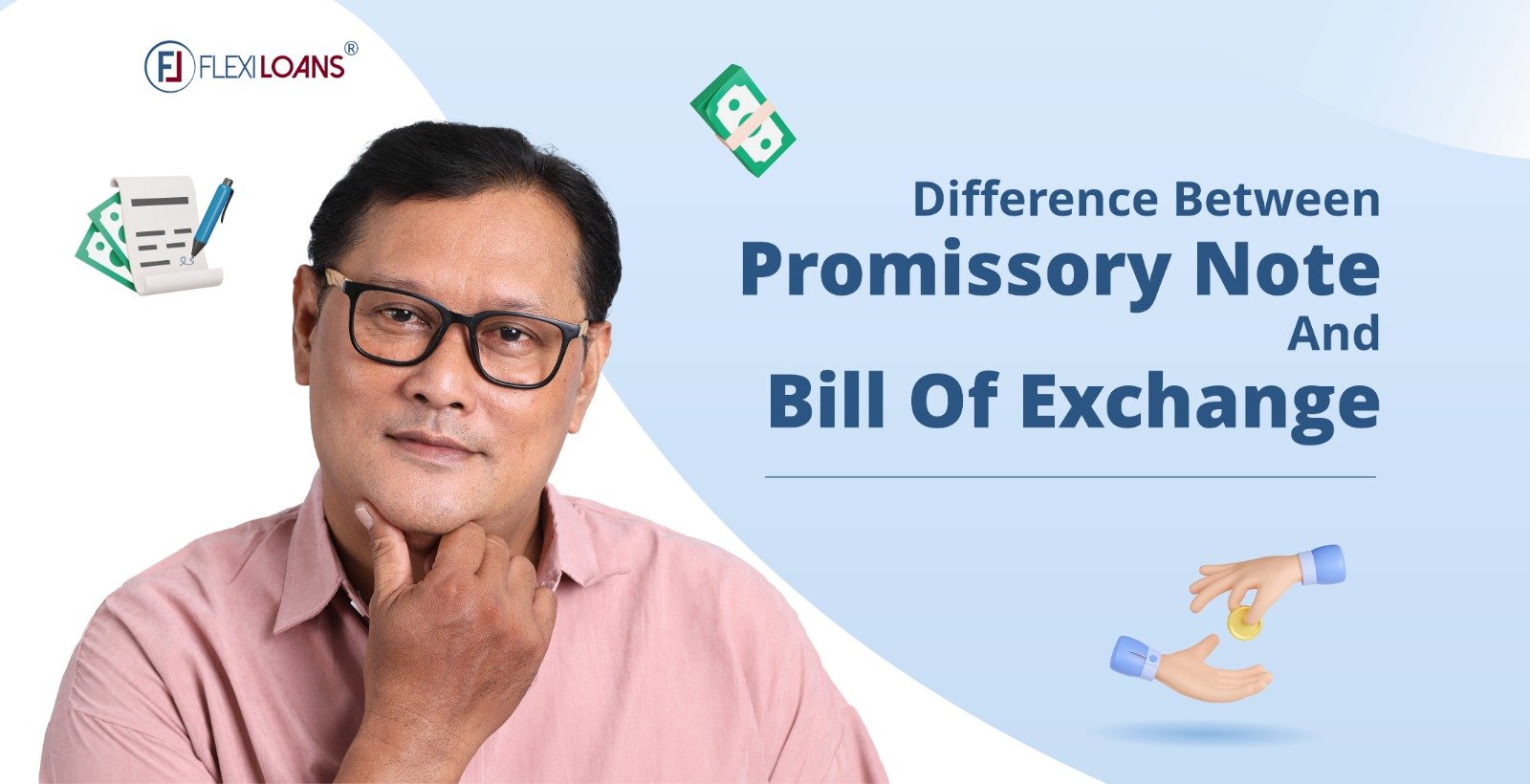Difference Between Promissory Note And Bill Of Exchange
Mar 05, 2024

Introduction
Promissory notes and bills of exchange are necessary credit instruments in business transactions. They provide written promises for payment of money. Though sharing some standard features, they have significant differences in the parties involved, liability conditions, negotiability, and usage. This makes it crucial to understand the distinctions between the two.
A promissory note involves only two parties – the maker, who promises to pay unconditionally, and the payee, who receives payment. A bill of exchange has three parties – the drawer who orders payment, the drawee who have to pay, and the payee who receives payment. There are also differences in grace period and recourse in case of dishonour. Knowing the differences allows for proper selection between the two instruments. So read on this article to understand the difference between promissory notes and bills of exchange in detail.
What is a Promissory Note?
A promissory note is a financial instrument containing a written promise to pay a specified sum of money. The maker who issues the note promises to pay the payee or bearer an amount on demand or at a specified future date. It is a negotiable instrument, implying it can be endorsed and transferred from one party to another. A promissory note provides proof of a debt obligation that the maker owes the payee. It also provides financing by enabling the payee to collect money from the maker in the future. The payee may discount or sell the note to convert it into cash immediately.
The note can also facilitate payments by allowing the maker to purchase goods or services from the payee on credit by providing a written promise to pay later. Promissory notes are versatile instruments that make credit transactions and short-term financing possible between parties through a binding written promise of future payment.
Uses of Promissory Notes
There are multiple uses of promissory notes. Let’s discuss a few of them:
- Proof of Debt
A promissory note acts as legal evidence of a debt or an obligation between the maker and the payee. It also helps to settle disputes or claims related to the debt.
- Source of Finance
A promissory note can act as a source of finance for the maker, who can borrow money from the payee or a third party by issuing a promissory note. The maker can also discount the promissory note with a bank or a financial institution and get cash in advance.
- Mode of Payment
A promissory note can also be a mode of payment by the maker, who can pay the payee or a third party by issuing a promissory note. The payee or the third party can either hold the promissory note till maturity or negotiate it with another person.
What is a Bill of Exchange?
A bill of exchange is a financial instrument containing a written order to pay. The drawer issues the bill instructing the drawee to pay the payee or bearer a specified amount on demand or at a future date. A bill of exchange performs essential functions in trade and commerce. It enables purchases on credit by allowing the drawer to order payment from the drawee at a later date. The payee can use the bill to raise funds immediately by getting it discounted from their bank. The bill facilitates payments for trade transactions, especially in international commerce.
It provides a convenient and secure method of international remittance. Parties involved can present the bill to banks for payment after endorsement. Overall, a bill of exchange is a versatile financial instrument that enables credit transactions, funds remittance and payments through a written order for payment from one party to another.
Uses of Bill of Exchange
There are multiple uses of bills of exchange, let’s discuss a few of them:
- Tool of Trade
A bill of exchange can be a tool of trade by the drawer, who can sell goods or services to the drawee or a third party by issuing a bill of exchange. The drawer can also discount the bill of exchange with a bank or a financial institution and get cash in advance.
- Means of Remittance
A bill of exchange can act as a means of remittance by the drawer, who can send money to the payee or a third party by issuing a bill of exchange. The payee or the third party can either hold the bill of exchange till maturity or negotiate it with another person.
- Method of Credit
A bill of exchange also acts as a method of credit by the drawer, who can grant credit to the drawee or a third party by issuing a bill of exchange. In contemporary financial scenarios, businesses may explore various avenues, such as business loan online, to extend credit using financial instruments like bills of exchange. The drawer can also accept the bill of exchange from the drawee or a third party and promise to pay at a future date.
How are Promissory Notes Different from Bills of Exchange?
Let’s shed light on the difference between a promissory note and a bill of exchange.
| Basis | Bills of Exchange | Promissory Notes |
| Meaning | A Bill of Exchange is a written order by one party (the drawer) to another (the drawee) to pay a specified sum to a third party (the payee) either on demand or at a specified future date. | A Promissory Note is a written promise by one party (the maker) to another (the payee) to pay a specified sum on demand or at a specified future date. |
| Parties Involved | Three parties – Drawer, Drawee, Payee | Two parties – Maker, Payee |
| Made By | Drawer (Creditor) | Maker (Debtor) |
| Contains | An unconditional order to pay | An unconditional promise to pay |
| Acceptance | Requires acceptance by the Drawee | It does not require acceptance |
| Liability | Drawer has secondary liability only if Drawee defaults | The maker has primary liability |
| Drawer as Payee | Permitted, if not payable to bearer on demand | Not permitted |
| Copies Made | One copy usually, three for foreign bills | Only one copy |
| Stamping Required | There is no need for a stamp | Stamp mandatory in all cases |
| Dishonour Notice | Notice to all liable parties is compulsory | Notice to Maker not required |
| Payable to Bearer | Permitted unless payable on demand | Not permitted |
| Grace Period | Three days of grace periods | No grace period |
| Maturity | Can be payable on demand, on sight, or after the fixed period | Payable on demand or after the fixed period |
| Interest | It may or may not carry interest | May carry interest |
| Limitation Period | 3 years from the date of maturity | 3 years from the date of issue |
| Material Alteration | If altered materially without consent, void against non-consenting parties | Void against Maker if altered materially |
| Ambiguity in Amount | Drawer is not liable if amount is not clear | Maker is liable to pay amount intended |
| Days of Grace | Three days of grace periods | No grace period |
| Endorsement | Endorsement is possible unlimited times | No endorsement |
| Attested | No attestation required | Requires attestation by witness |
| Usage | In domestic and international trade | In domestic transactions |
| Retirement | Retirement does not need maturity | Maker compulsorily does retirement on maturity |
Conclusion
You have learned the difference between bills of exchange and promissory notes in this article. Both are negotiable instruments that facilitate trade and commerce, but they have distinct features and purposes. You write a bill of exchange as a written order to a debtor to pay a certain amount at a specified time or on demand. You write a promissory note as a written promise to a creditor to pay a certain amount at a specified time or on demand. Hopefully, this article has made the distinction between bills of exchange and promissory notes clear for you. This information is useful when making decisions regarding such matters in either business or personal transactions. It is always advisable to verify the legitimacy, authenticity and legality of any negotiable instrument prior to its acceptance or issuance.If you are looking for a reliable and flexible source of financing for your business, consider FlexiLoans. Whether you’re seeking an unsеcurеd business loan, a small business loan, or a working capital loan, we offer tailored solutions for your needs. Our business loan EMI calculator helps you plan your finances effectively. As an MSME loan, we understand your unique requirements—partner with us to fuel your business aspirations and thrive in a dynamic market. Visit our website or contact us today to find out more.
FAQ’s
Ans: The similarities between bills of exchange and promissory notes are that they both establish a legal relationship between the two parties where one party pays the other.
Ans: The nature and aim of currency notes and promissory notes are different. The central bank issues currency notes that are legal tender for transactions and can be used as a mode of exchange. Contrastingly, a promissory note is an agreement in writing made by one party to pay another party the amount of money as defined within the agreed time.
Ans: The nature and functions of the promissory note are quite distinct from those of a cheque. A promissory note is a written promise of payment within the specified time to an amount, more usually between two parties or persons. On the other hand, a cheque is an order written by an account holder in favour of their bank to pay out a specified amount of money for one who has been identified as a beneficiary.
Ans: A promissory note is less structured than an agreement involving business loans, and you can use it when the debtor owes relatively small sums. However, both documents are legally binding.
Ans: The Note-holder is the person who takes the promissory note by the transfer and to whom payments under this promissory note should be made.
Ans: A bill of exchange is an unconditional order written document. The writer of the bill of exchange signs it. The writing instructs one person to deliver a certain amount of money to another individual or whoever has the document. Alternatively, a promissory note is simply an unconditional written undertaking. The maker signs the promissory note. In the document, it is promised to pay a specific amount of money only to his or her name or in an order from that person. It can also offer to pay whoever owns the document.
Ans: Yes, you use promissory notes for several types of loans, such as mortgages, car loans, online business loans, and others.
Ans: All Promissory Notes are only valid for three years from the date of their execution, after which they will be invalid. There are no limits at all in terms of the amount which one can lend or borrow.
Ans: A promissory note is a legal instrument that represents a promise to make the payment in the agreed amount and at an agreed time to an identifiable beneficiary.
Ans: A drawer is a person who draws a bill of exchange or cheque to pay the specified sum to a third party.








